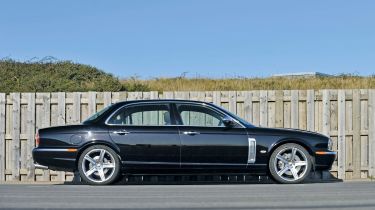Jaguar XJ (X350)
Built: 2003-09, number sold: 295,365 to date, cool cat rating: 3/5
The seventh-generation XJ brought Jaguar’s flagship saloon right up to date. Launched in 2003, the car – codenamed X350 – had curvaceous styling that bore a strong resemblance to the previous model. But as it drew on the resources of then owner Ford, this XJ was a true 21st century Jaguar.
The chassis was made of aluminium, so was 40 per cent lighter yet 60 per cent stiffer than that of its predecessor. Plus, air-suspension and a more spacious interior ensured the newcomer could truly compete with its class-leading German rivals.
After an absence of several years, this XJ saw the return of the six-cylinder engine – with the 3.0-litre V6 used in the S and X-Type offered alongside 3.5 and 4.2-litre V8s. Diesel was starting to dominate this class in Europe at the time, so in 2005, a 2.7-litre twin-turbo oil-burner was introduced. The following year, Jaguar carried out a styling update, cleaning up the shape with flush glass and fewer trim mouldings.
Further small cosmetic changes were introduced in 2007, and with the all-new XJ set to arrive in showrooms next year, the last few examples of the existing car come with either the 2.7-litre diesel or a supercharged 4.2-litre V8 petrol engine. Yet although the X350 is on the way out, and represents the last of the retro-designed Jaguars, it deserves its place in our line-up. It pioneered the aluminium body construction that
will also underpin the dramatic new car.
What’s more, the outgoing XJ was the final Jaguar to have been produced at the famous Browns Lane factory in Coventry, which has now closed. The black model in our pictures was the first production X350 to roll off the line in December 2002, and was delivered straight to the museum.
Details
WHY: Aluminium chassis pioneer was also the last of the Browns Lane line!






